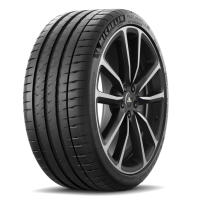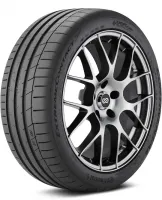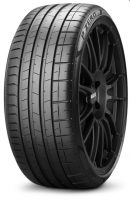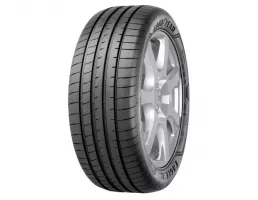| Test Summary | |
| Array | Michelin Pilot Sport 4 S |
| Array | Continental ExtremeContact Sport |
| Array | Pirelli P Zero PZ4 |
| Array | Michelin Pilot Sport 4 S |
| Array | Michelin Pilot Sport 4 S |
| Array | Pirelli P Zero PZ4 Hankook Ventus V12 evo2 |
The biggest surprise of the test? The fact the Michelin Pilot Sport 4 S is available in 18" sizes in America, but only 19" and above in Europe. Another idiosyncrasy of an American market test is the Continental ExtremeContact range, which isn't available in Europe, but fairly safe to assume the tire on test here is broadly similar to the Continental Sport Contact 6.
Dry
In the dry the Michelin dominated, winning the dry handling tests by an impressive margin and finishing joint first under dry braking. The Michelin had the best steering feel and balance in the test, which allowed the tester to push harder with more confidence.
Wet
In the wet the balance between the Continental and Michelin was reversed, with the German tire manufacturer taking a big win under wet braking and holding onto that advantage during the wet circle test. As in the dry testing, the subjective confidence of the Continental in the wet earned it first place, rather than outright grip.
The Hankook was the quietest tire on test, but the margin between the top three tires was only one dB
Results
1st: Michelin Pilot Sport 4 S | |

| The Pilot Sport 4 S bundled the test’s highest lateral grip and shortest stopping distance into the only sub-30-second lap time. That betters the next-fastest tire, Pirelli’s P Zero, by 0.5 second. Read Reviews Buy from £253.99In driving, speed usually grows as confidence grows, and this Michelin exemplifies that idea. The Pilot Sport 4 S assures the driver with its tenacious grip, stellar lateral stiffness, and progressive at-the-limit behavior. It is easy and rewarding to drive aggressively, and it allows the driver to return to full throttle earlier than any other tire in this test. Out in the real world, the Michelin demonstrated a subtle tendency to follow grooves in the road. Otherwise, the Pilot Sport 4 S is as docile in traffic as it is around a racetrack, never hammering down imperfections nor singing on the smooth stuff. As with the Pilot Super Sport, Michelin is likely to be faced with so many automakers eager to fit the 4 S to their sports cars that it will turn customers away. Fortunately, you don’t need Michelin’s approval to fit your car with Pilot Sport 4 S tires. |
2nd: Continental ExtremeContact Sport | |

| Senna at Donington. Hunt in Japan. ExtremeContact Sport in South Bend. Okay, the Continental can’t make you a wet-weather hero, but it is the choice tire when both rain and pilot are driving hard. The Continental swept all three wet tests with big margins and showed the smallest performance drop-off between dry and wet tests. Chief among its waterproof virtues, the Continental maintains relatively high grip when the tire starts to slide, unlike the Pirellis and Goodyears. Read Reviews Buy from £204.99The ExtremeContact Sport locked in second place with a solid performance in the dry, although not exactly threatening the Michelin. It delivers sharp steering precision that makes it feel alert and responsive when driven casually, but that quality fades when pushed past the limit in the dry. Our ears registered louder thwacks compared with the competitors over the same cracks and expansion joints on-road—similar to the almost metallic clank of a bouncing basketball. But that’s a small price to pay for exceptional wet grip and impressive dry performance. Plus, Continental asks only $164 for the ExtremeContact Sport, $34 less than our winner. |
3rd: Pirelli P Zero PZ4 | |

| Pirelli’s latest P Zero—reengineered for 2016 and identified by a small PZ4 molded into the sidewall—can be driven fairly quickly, as evidenced by its dry lap time, the second fastest in the test. Doing so, however, requires focus to toe the limit and patience to delay throttle inputs slightly. Without that diligence, it becomes easy to overdrive the tire, at which point grip levels fall off rapidly—but not as detrimentally as with the Goodyear—making graceful and quick recovery difficult. Read Reviews Even a driver of Geswein’s caliber can’t make the P Zero more than a midpack performer in the wet, as the Pirelli’s grip takes a big hit when the water flows. The P Zero used 109 feet of pavement to stop from 50 mph in the wet, 14 feet more than the best-in-test Continental. The Pirelli also tied the Goodyear for the lowest lateral grip in the wet at 0.75 g. But it does offer commendable compliance on the road, and at $153 apiece, it’s the cheapest tire here. When we look at the test results, though, there’s a clear dividing line separating the top tier from the rest of the class. The Pirelli is on the wrong side of it. |
4th: Hankook Ventus V12 evo2 | |

| This tire possesses the rare and admirable ability to maintain relatively high grip compared with its peak grip even as the tire begins to slide. This is particularly apparent when the front end begins to push into understeer. Where other tires scrub speed and sail off the driving line, the Hankooks hang on longer and with only a slight drift off the intended path. This means the driver is scarcely penalized for sloppy piloting. The Hankook is easy to drive at the limit, with quicker than average recovery when the driver attempts to reel it all in. Read Reviews Buy from £198.99In other categories, the Hankook impresses less. The Ventus V12 Evo2 is laterally soft when loaded up in a corner, and steering inputs are imprecise. On wet surfaces, its favorable progressivism dries up. It also emits tones that penetrate the cabin, with a high-pitched zip as it rolls and loud thumps over imperfections. And while easy to drive, the Hankook's performances in both dry and wet tests were only marginally better than those of the Goodyear. Its fourth-place position was cemented by this objective performance that placed it in, well, fourth place. |
5th: Goodyear Eagle F1 Asymmetric 3 | |

| At $180 per tire, the Goodyear Eagle F1 Asymmetric 3 carries a price premium that can’t be justified by its performance. Despite costing $27 more than the cheapest tire in our test, the Goodyear was the caboose in every performance metric except for wet braking. In that test, the Goodyear’s 107-foot stop landed it in third place. Read Reviews It also wilts under subjective scrutiny, lacking high lateral firmness, the ability to impart steering feel, and the progressive rise and fall of adhesion as you approach and exceed its ultimate grip. Geswein noted that “excursions beyond the limit kill lap times,†as grip is slow to return once the tire starts to slide. Even on our road drive, when our butts and ears were tuned to observe ride quality and road noise, we couldn’t help but notice that the Goodyear Eagle F1 Asymmetric 3 was unsettled by midcorner bumps in ways the other tires weren’t. Goodyear’s tire does deliver less ride harshness than both the Hankook and Continental tires, and road noise is nicely managed, but neither of those qualities is what makes a summer performÂance tire great. |







